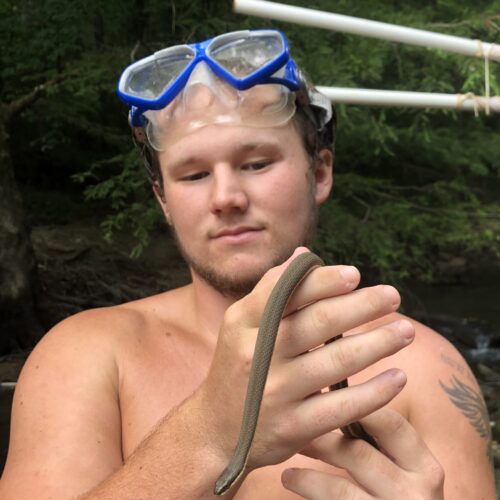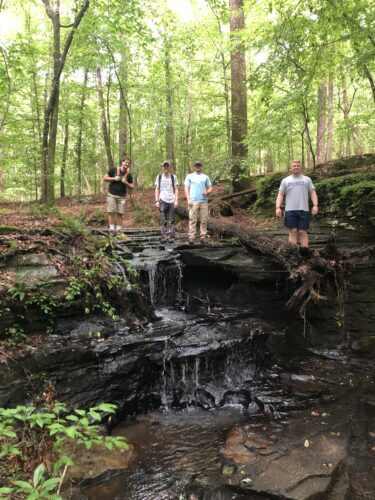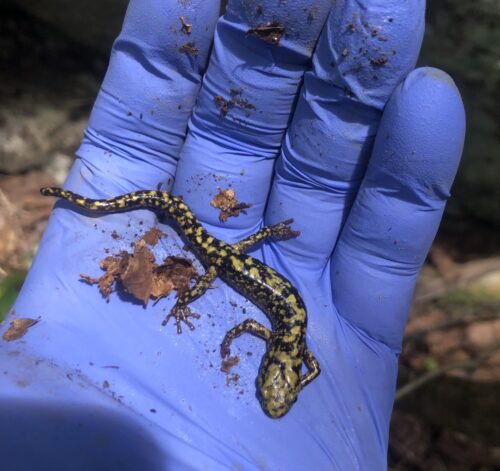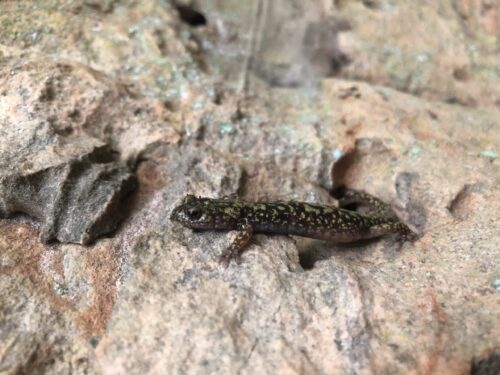 Millsaps alumnus Bailey Watkins, ’23, partnered with Dr. Will Selman, associate professor of biology, on a research project that has shed new light on the distribution of green salamanders in Mississippi. Their findings were recently published in the peer-reviewed journal “Herpetological Conservation and Biology.”
Millsaps alumnus Bailey Watkins, ’23, partnered with Dr. Will Selman, associate professor of biology, on a research project that has shed new light on the distribution of green salamanders in Mississippi. Their findings were recently published in the peer-reviewed journal “Herpetological Conservation and Biology.”
As part of his undergraduate honors project in biology, Watkins didn’t just study salamanders in a textbook. He searched for them them in the field, collected data, analyzed results and contributed to real scientific discovery.
Working alongside Dr. Selman, Watkins helped reveal that green salamanders are found in more locations across Mississippi than previously documented.
His interest in the project grew after taking several of Dr. Selman’s courses in wildlife biology and environmental science. “I always found his classes incredibly fascinating,” Bailey explained. “When Dr. Selman introduced the idea of salamander distribution and abundance research during an advising meeting, I was eager to get involved.”
 For Dr. Selman, the project was rooted in Mississippi’s unique ecology. “The habitat in northeastern Mississippi is different than the rest of the state,” he said. “There’s a small pocket in Tishomingo County that looks more like the Appalachian Mountains, with huge rock walls and a really unique environment. Because we’re here in Mississippi, I wanted to take students into that landscape, not only to experience it, but to use it as something we could study.”
For Dr. Selman, the project was rooted in Mississippi’s unique ecology. “The habitat in northeastern Mississippi is different than the rest of the state,” he said. “There’s a small pocket in Tishomingo County that looks more like the Appalachian Mountains, with huge rock walls and a really unique environment. Because we’re here in Mississippi, I wanted to take students into that landscape, not only to experience it, but to use it as something we could study.”
With a team of other Millsaps students, Watkins conducted fieldwork for two summers, spending long days and nights surveying salamanders in Tishomingo State Park and throughout northeast Mississippi. They explored cracks, crevices and rocky outcrops, documenting each salamander sighting in detail including age class, height above ground, type of crevice and whether females were tending eggs.
“The green salamanders are linked to rock habitat,” Dr. Selman said. “We mapped out known areas, but we also discovered new ones. We even collected small tail samples for possible DNA analysis to compare populations across rock outcrops.”
The rugged terrain was a challenge. “We often had to climb through steep, heavily vegetated areas, which made the surveys both physically demanding and rewarding,” Watkins said.
 The team’s research revealed that green salamanders were present in far more locations than previously documented, with encounter rates in Mississippi similar to or above those reported elsewhere in their range. These results highlight the importance of amphibians as indicators of ecosystem health and demonstrate the value of conservation-focused fieldwork. “The most rewarding aspect was working alongside such a great research team and knowing I was part of something unique, an opportunity that many other colleges wouldn’t offer,” he said.
The team’s research revealed that green salamanders were present in far more locations than previously documented, with encounter rates in Mississippi similar to or above those reported elsewhere in their range. These results highlight the importance of amphibians as indicators of ecosystem health and demonstrate the value of conservation-focused fieldwork. “The most rewarding aspect was working alongside such a great research team and knowing I was part of something unique, an opportunity that many other colleges wouldn’t offer,” he said.
Watkins completed this project as part of his Honors work in biology, and his dedication has carried forward into his professional career. After interning with Allen Engineering and Science while at Millsaps, Watkins now works with the company in Mobile, Alabama as an environmental biologist.
In his current role, he spends much of his time conducting field surveys and habitat assessments for clients. His day-to-day work often involves searching for, identifying and documenting plant and animal species, evaluating ecosystems and preparing reports to ensure development projects meet environmental regulations. The skills he honed in his undergraduate field work directly translate to his work today.
 By combining student curiosity & faculty mentorship, this research exemplifies Millsaps’ commitment to meaningful, hands-on learning that prepares students to make an impact in science and conservation.
By combining student curiosity & faculty mentorship, this research exemplifies Millsaps’ commitment to meaningful, hands-on learning that prepares students to make an impact in science and conservation.
This research project shows what can happen when curious students and supportive faculty come together. Hands-on learning happens and scientific knowledge is expanded. Plus, Bailey gained the practical skills and confidence that set him up for the job he has today.
